Strategies for Effective Business Communication: An Australian MNC
VerifiedAdded on 2020/02/24
|11
|3664
|58
Report
AI Summary
This report examines the critical role of effective business communication within an Australian multinational corporation (MNC). It begins by highlighting the importance of communication and then delves into good practices, including the communication channels employed by renowned MNCs like Tesco, Nike, and Coca-Cola. The report proposes future strategies focusing on real-time communication with staff and customers, facilitating communication with front-line employees, and gathering feedback from clients to improve product quality and service delivery. Furthermore, it addresses cross-cultural issues in different contexts, emphasizing the importance of adaptability and cultural sensitivity. The report concludes by summarizing the key findings and recommendations for enhancing communication effectiveness within the Australian MNC, ensuring smooth operations and improved customer relations.

Effective Business Communication
Paraphrase This Document
Need a fresh take? Get an instant paraphrase of this document with our AI Paraphraser
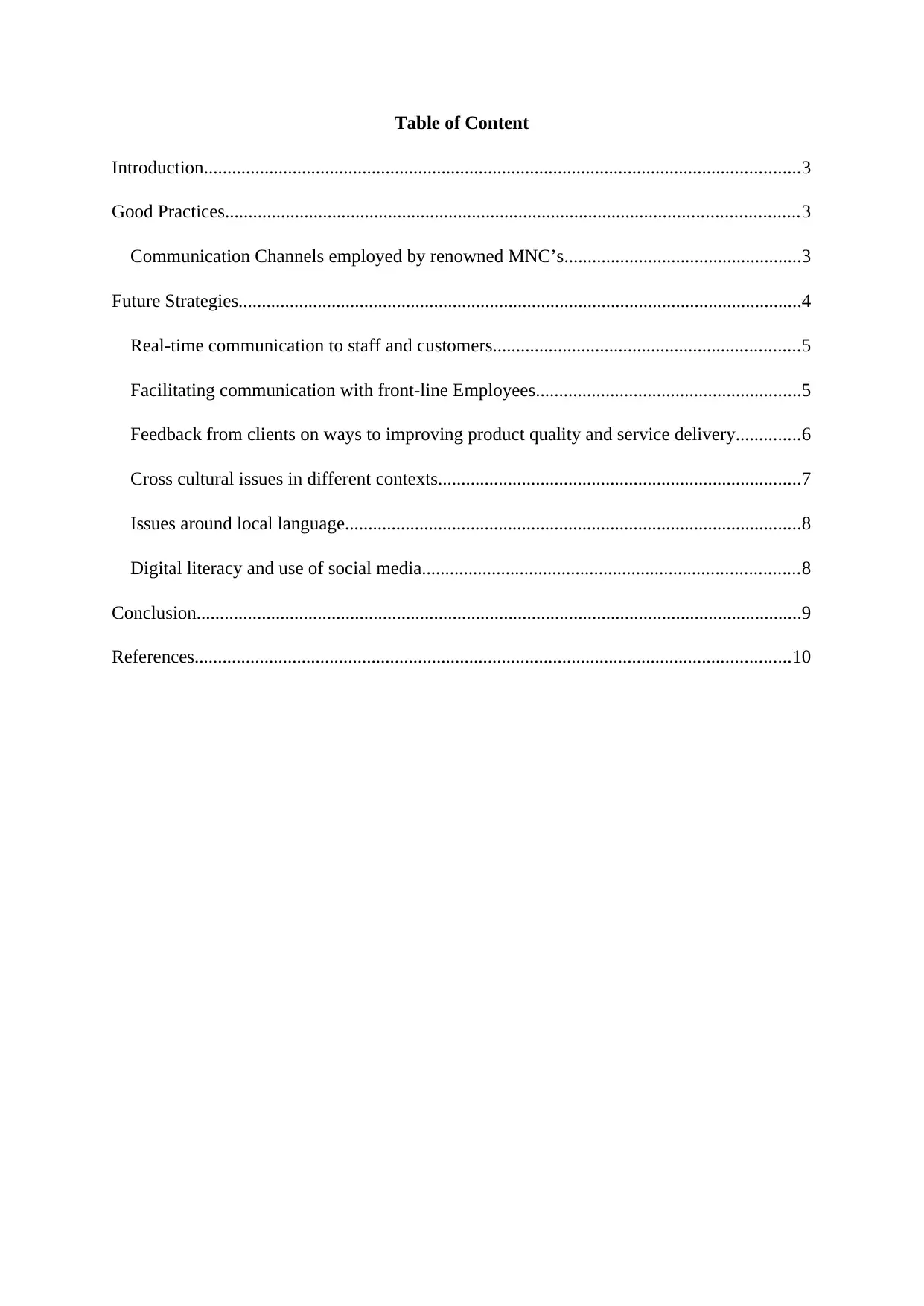
Table of Content
Introduction................................................................................................................................3
Good Practices...........................................................................................................................3
Communication Channels employed by renowned MNC’s...................................................3
Future Strategies.........................................................................................................................4
Real-time communication to staff and customers..................................................................5
Facilitating communication with front-line Employees.........................................................5
Feedback from clients on ways to improving product quality and service delivery..............6
Cross cultural issues in different contexts..............................................................................7
Issues around local language..................................................................................................8
Digital literacy and use of social media.................................................................................8
Conclusion..................................................................................................................................9
References................................................................................................................................10
Introduction................................................................................................................................3
Good Practices...........................................................................................................................3
Communication Channels employed by renowned MNC’s...................................................3
Future Strategies.........................................................................................................................4
Real-time communication to staff and customers..................................................................5
Facilitating communication with front-line Employees.........................................................5
Feedback from clients on ways to improving product quality and service delivery..............6
Cross cultural issues in different contexts..............................................................................7
Issues around local language..................................................................................................8
Digital literacy and use of social media.................................................................................8
Conclusion..................................................................................................................................9
References................................................................................................................................10
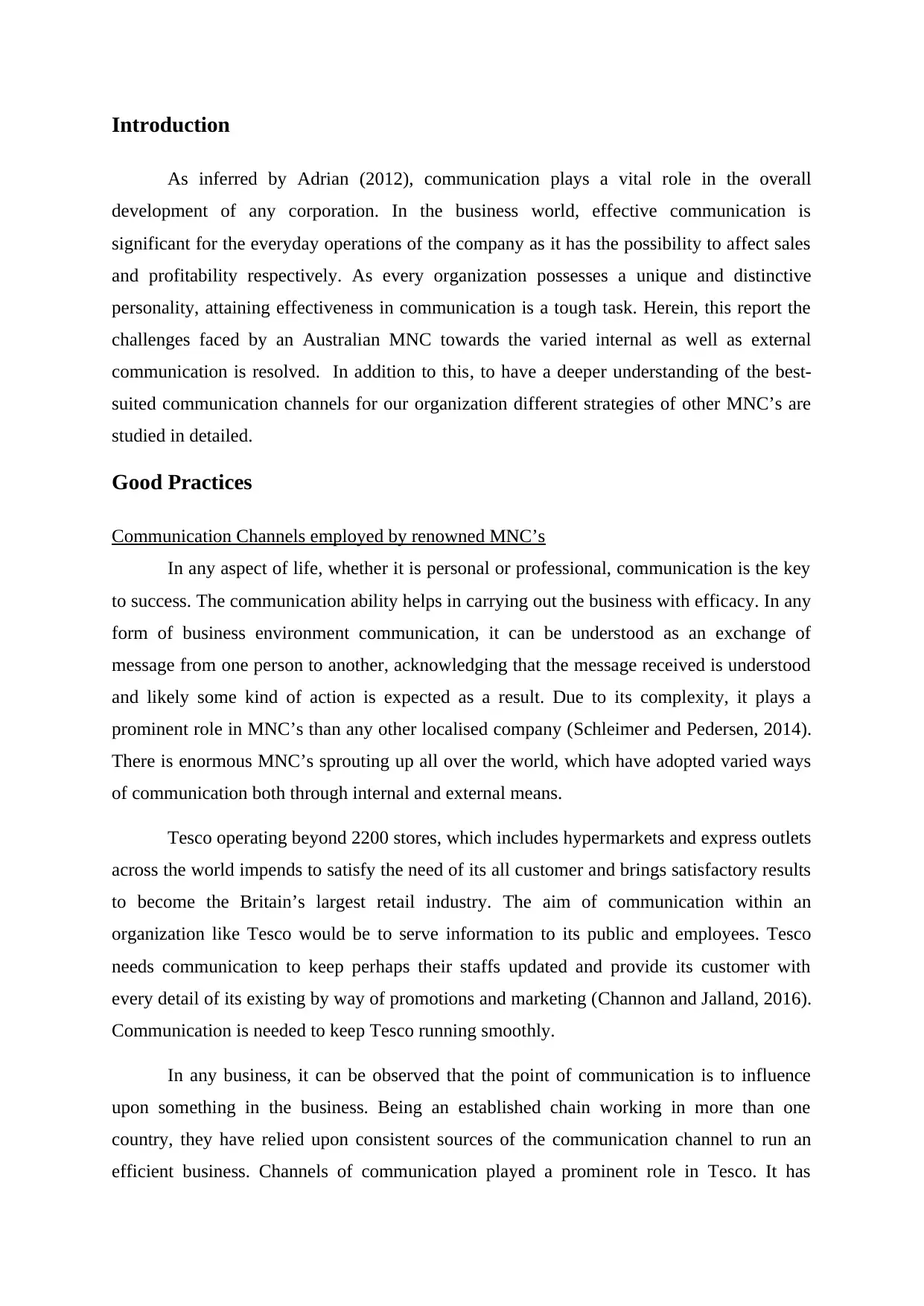
Introduction
As inferred by Adrian (2012), communication plays a vital role in the overall
development of any corporation. In the business world, effective communication is
significant for the everyday operations of the company as it has the possibility to affect sales
and profitability respectively. As every organization possesses a unique and distinctive
personality, attaining effectiveness in communication is a tough task. Herein, this report the
challenges faced by an Australian MNC towards the varied internal as well as external
communication is resolved. In addition to this, to have a deeper understanding of the best-
suited communication channels for our organization different strategies of other MNC’s are
studied in detailed.
Good Practices
Communication Channels employed by renowned MNC’s
In any aspect of life, whether it is personal or professional, communication is the key
to success. The communication ability helps in carrying out the business with efficacy. In any
form of business environment communication, it can be understood as an exchange of
message from one person to another, acknowledging that the message received is understood
and likely some kind of action is expected as a result. Due to its complexity, it plays a
prominent role in MNC’s than any other localised company (Schleimer and Pedersen, 2014).
There is enormous MNC’s sprouting up all over the world, which have adopted varied ways
of communication both through internal and external means.
Tesco operating beyond 2200 stores, which includes hypermarkets and express outlets
across the world impends to satisfy the need of its all customer and brings satisfactory results
to become the Britain’s largest retail industry. The aim of communication within an
organization like Tesco would be to serve information to its public and employees. Tesco
needs communication to keep perhaps their staffs updated and provide its customer with
every detail of its existing by way of promotions and marketing (Channon and Jalland, 2016).
Communication is needed to keep Tesco running smoothly.
In any business, it can be observed that the point of communication is to influence
upon something in the business. Being an established chain working in more than one
country, they have relied upon consistent sources of the communication channel to run an
efficient business. Channels of communication played a prominent role in Tesco. It has
As inferred by Adrian (2012), communication plays a vital role in the overall
development of any corporation. In the business world, effective communication is
significant for the everyday operations of the company as it has the possibility to affect sales
and profitability respectively. As every organization possesses a unique and distinctive
personality, attaining effectiveness in communication is a tough task. Herein, this report the
challenges faced by an Australian MNC towards the varied internal as well as external
communication is resolved. In addition to this, to have a deeper understanding of the best-
suited communication channels for our organization different strategies of other MNC’s are
studied in detailed.
Good Practices
Communication Channels employed by renowned MNC’s
In any aspect of life, whether it is personal or professional, communication is the key
to success. The communication ability helps in carrying out the business with efficacy. In any
form of business environment communication, it can be understood as an exchange of
message from one person to another, acknowledging that the message received is understood
and likely some kind of action is expected as a result. Due to its complexity, it plays a
prominent role in MNC’s than any other localised company (Schleimer and Pedersen, 2014).
There is enormous MNC’s sprouting up all over the world, which have adopted varied ways
of communication both through internal and external means.
Tesco operating beyond 2200 stores, which includes hypermarkets and express outlets
across the world impends to satisfy the need of its all customer and brings satisfactory results
to become the Britain’s largest retail industry. The aim of communication within an
organization like Tesco would be to serve information to its public and employees. Tesco
needs communication to keep perhaps their staffs updated and provide its customer with
every detail of its existing by way of promotions and marketing (Channon and Jalland, 2016).
Communication is needed to keep Tesco running smoothly.
In any business, it can be observed that the point of communication is to influence
upon something in the business. Being an established chain working in more than one
country, they have relied upon consistent sources of the communication channel to run an
efficient business. Channels of communication played a prominent role in Tesco. It has
⊘ This is a preview!⊘
Do you want full access?
Subscribe today to unlock all pages.

Trusted by 1+ million students worldwide
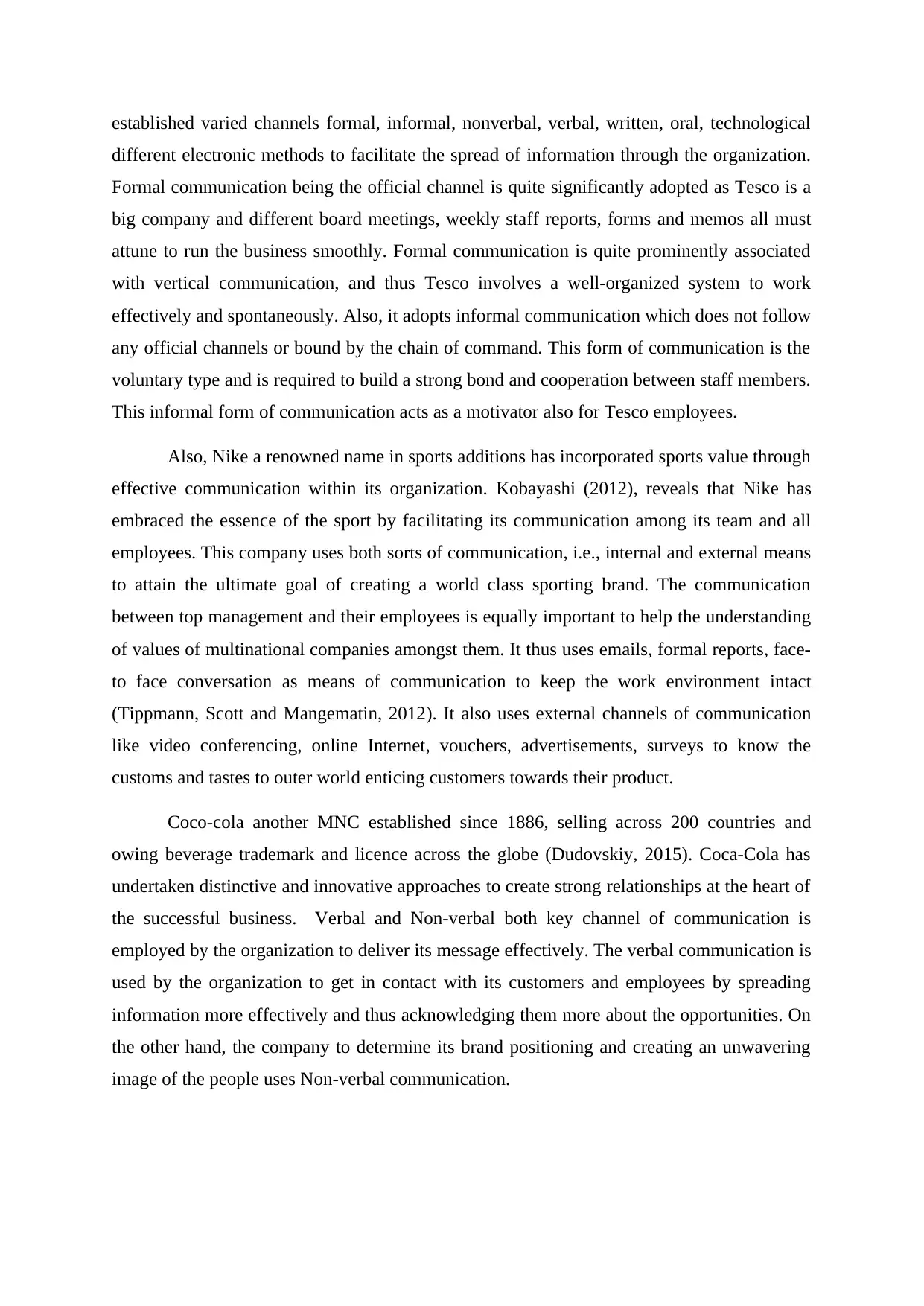
established varied channels formal, informal, nonverbal, verbal, written, oral, technological
different electronic methods to facilitate the spread of information through the organization.
Formal communication being the official channel is quite significantly adopted as Tesco is a
big company and different board meetings, weekly staff reports, forms and memos all must
attune to run the business smoothly. Formal communication is quite prominently associated
with vertical communication, and thus Tesco involves a well-organized system to work
effectively and spontaneously. Also, it adopts informal communication which does not follow
any official channels or bound by the chain of command. This form of communication is the
voluntary type and is required to build a strong bond and cooperation between staff members.
This informal form of communication acts as a motivator also for Tesco employees.
Also, Nike a renowned name in sports additions has incorporated sports value through
effective communication within its organization. Kobayashi (2012), reveals that Nike has
embraced the essence of the sport by facilitating its communication among its team and all
employees. This company uses both sorts of communication, i.e., internal and external means
to attain the ultimate goal of creating a world class sporting brand. The communication
between top management and their employees is equally important to help the understanding
of values of multinational companies amongst them. It thus uses emails, formal reports, face-
to face conversation as means of communication to keep the work environment intact
(Tippmann, Scott and Mangematin, 2012). It also uses external channels of communication
like video conferencing, online Internet, vouchers, advertisements, surveys to know the
customs and tastes to outer world enticing customers towards their product.
Coco-cola another MNC established since 1886, selling across 200 countries and
owing beverage trademark and licence across the globe (Dudovskiy, 2015). Coca-Cola has
undertaken distinctive and innovative approaches to create strong relationships at the heart of
the successful business. Verbal and Non-verbal both key channel of communication is
employed by the organization to deliver its message effectively. The verbal communication is
used by the organization to get in contact with its customers and employees by spreading
information more effectively and thus acknowledging them more about the opportunities. On
the other hand, the company to determine its brand positioning and creating an unwavering
image of the people uses Non-verbal communication.
different electronic methods to facilitate the spread of information through the organization.
Formal communication being the official channel is quite significantly adopted as Tesco is a
big company and different board meetings, weekly staff reports, forms and memos all must
attune to run the business smoothly. Formal communication is quite prominently associated
with vertical communication, and thus Tesco involves a well-organized system to work
effectively and spontaneously. Also, it adopts informal communication which does not follow
any official channels or bound by the chain of command. This form of communication is the
voluntary type and is required to build a strong bond and cooperation between staff members.
This informal form of communication acts as a motivator also for Tesco employees.
Also, Nike a renowned name in sports additions has incorporated sports value through
effective communication within its organization. Kobayashi (2012), reveals that Nike has
embraced the essence of the sport by facilitating its communication among its team and all
employees. This company uses both sorts of communication, i.e., internal and external means
to attain the ultimate goal of creating a world class sporting brand. The communication
between top management and their employees is equally important to help the understanding
of values of multinational companies amongst them. It thus uses emails, formal reports, face-
to face conversation as means of communication to keep the work environment intact
(Tippmann, Scott and Mangematin, 2012). It also uses external channels of communication
like video conferencing, online Internet, vouchers, advertisements, surveys to know the
customs and tastes to outer world enticing customers towards their product.
Coco-cola another MNC established since 1886, selling across 200 countries and
owing beverage trademark and licence across the globe (Dudovskiy, 2015). Coca-Cola has
undertaken distinctive and innovative approaches to create strong relationships at the heart of
the successful business. Verbal and Non-verbal both key channel of communication is
employed by the organization to deliver its message effectively. The verbal communication is
used by the organization to get in contact with its customers and employees by spreading
information more effectively and thus acknowledging them more about the opportunities. On
the other hand, the company to determine its brand positioning and creating an unwavering
image of the people uses Non-verbal communication.
Paraphrase This Document
Need a fresh take? Get an instant paraphrase of this document with our AI Paraphraser
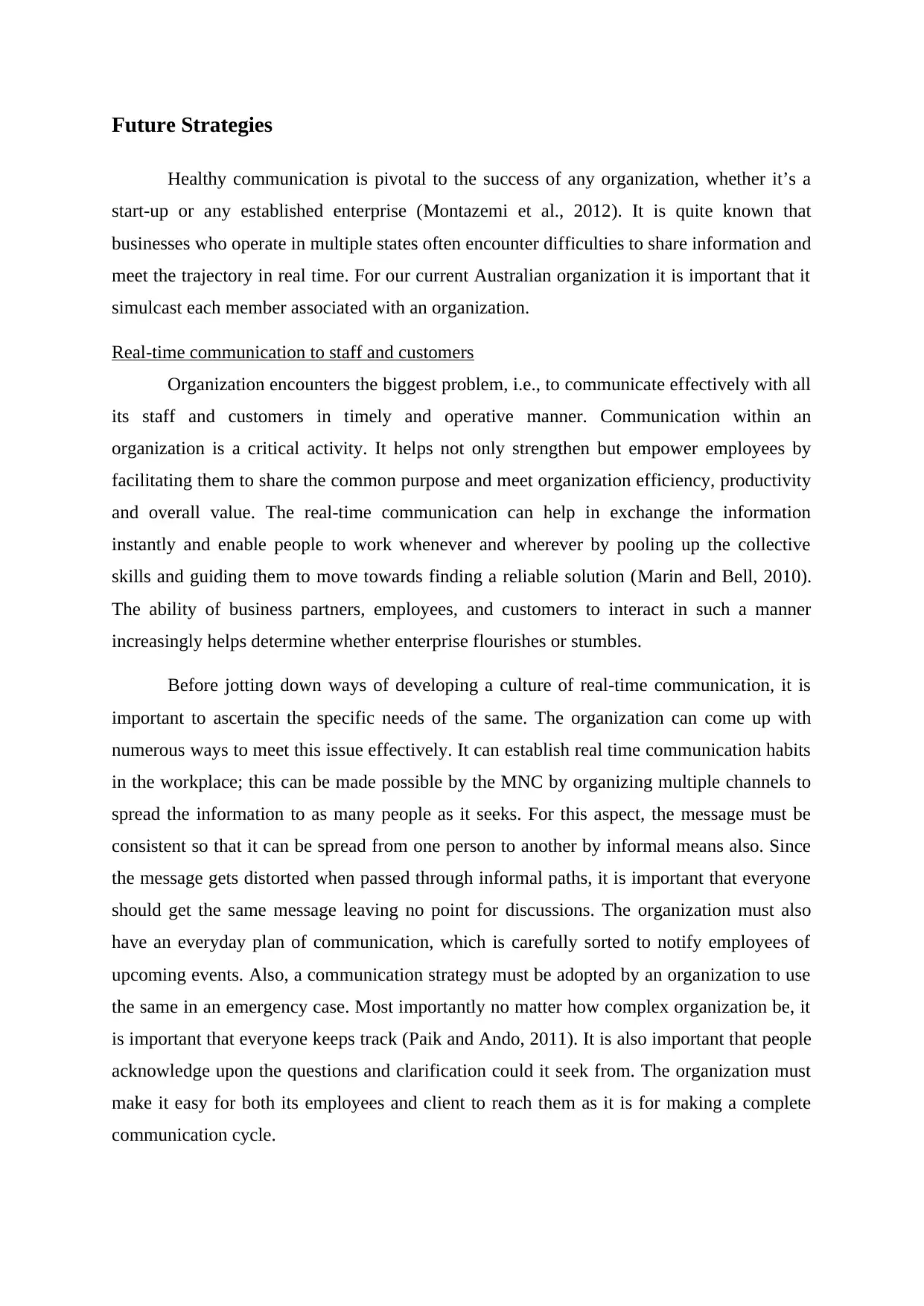
Future Strategies
Healthy communication is pivotal to the success of any organization, whether it’s a
start-up or any established enterprise (Montazemi et al., 2012). It is quite known that
businesses who operate in multiple states often encounter difficulties to share information and
meet the trajectory in real time. For our current Australian organization it is important that it
simulcast each member associated with an organization.
Real-time communication to staff and customers
Organization encounters the biggest problem, i.e., to communicate effectively with all
its staff and customers in timely and operative manner. Communication within an
organization is a critical activity. It helps not only strengthen but empower employees by
facilitating them to share the common purpose and meet organization efficiency, productivity
and overall value. The real-time communication can help in exchange the information
instantly and enable people to work whenever and wherever by pooling up the collective
skills and guiding them to move towards finding a reliable solution (Marin and Bell, 2010).
The ability of business partners, employees, and customers to interact in such a manner
increasingly helps determine whether enterprise flourishes or stumbles.
Before jotting down ways of developing a culture of real-time communication, it is
important to ascertain the specific needs of the same. The organization can come up with
numerous ways to meet this issue effectively. It can establish real time communication habits
in the workplace; this can be made possible by the MNC by organizing multiple channels to
spread the information to as many people as it seeks. For this aspect, the message must be
consistent so that it can be spread from one person to another by informal means also. Since
the message gets distorted when passed through informal paths, it is important that everyone
should get the same message leaving no point for discussions. The organization must also
have an everyday plan of communication, which is carefully sorted to notify employees of
upcoming events. Also, a communication strategy must be adopted by an organization to use
the same in an emergency case. Most importantly no matter how complex organization be, it
is important that everyone keeps track (Paik and Ando, 2011). It is also important that people
acknowledge upon the questions and clarification could it seek from. The organization must
make it easy for both its employees and client to reach them as it is for making a complete
communication cycle.
Healthy communication is pivotal to the success of any organization, whether it’s a
start-up or any established enterprise (Montazemi et al., 2012). It is quite known that
businesses who operate in multiple states often encounter difficulties to share information and
meet the trajectory in real time. For our current Australian organization it is important that it
simulcast each member associated with an organization.
Real-time communication to staff and customers
Organization encounters the biggest problem, i.e., to communicate effectively with all
its staff and customers in timely and operative manner. Communication within an
organization is a critical activity. It helps not only strengthen but empower employees by
facilitating them to share the common purpose and meet organization efficiency, productivity
and overall value. The real-time communication can help in exchange the information
instantly and enable people to work whenever and wherever by pooling up the collective
skills and guiding them to move towards finding a reliable solution (Marin and Bell, 2010).
The ability of business partners, employees, and customers to interact in such a manner
increasingly helps determine whether enterprise flourishes or stumbles.
Before jotting down ways of developing a culture of real-time communication, it is
important to ascertain the specific needs of the same. The organization can come up with
numerous ways to meet this issue effectively. It can establish real time communication habits
in the workplace; this can be made possible by the MNC by organizing multiple channels to
spread the information to as many people as it seeks. For this aspect, the message must be
consistent so that it can be spread from one person to another by informal means also. Since
the message gets distorted when passed through informal paths, it is important that everyone
should get the same message leaving no point for discussions. The organization must also
have an everyday plan of communication, which is carefully sorted to notify employees of
upcoming events. Also, a communication strategy must be adopted by an organization to use
the same in an emergency case. Most importantly no matter how complex organization be, it
is important that everyone keeps track (Paik and Ando, 2011). It is also important that people
acknowledge upon the questions and clarification could it seek from. The organization must
make it easy for both its employees and client to reach them as it is for making a complete
communication cycle.
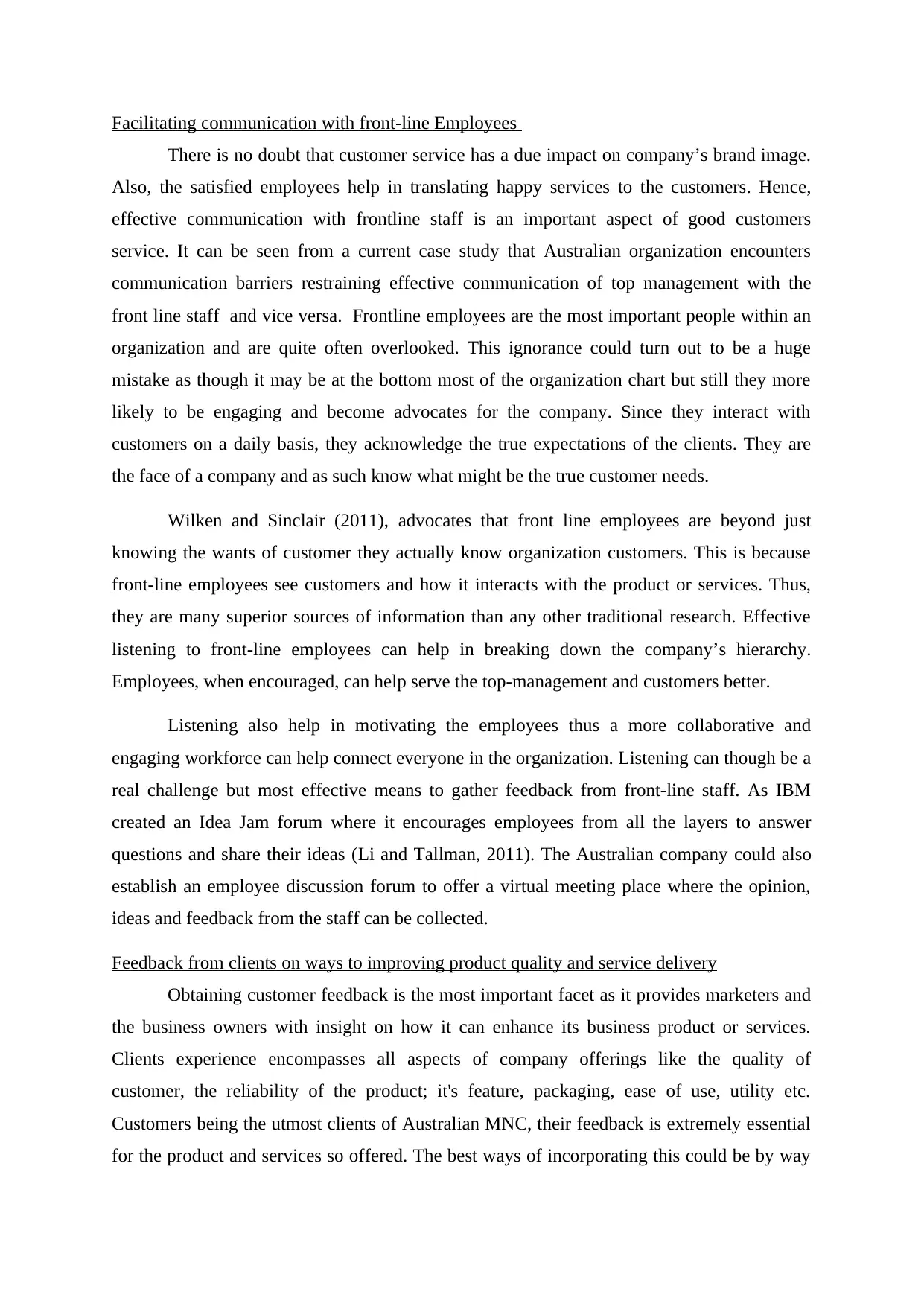
Facilitating communication with front-line Employees
There is no doubt that customer service has a due impact on company’s brand image.
Also, the satisfied employees help in translating happy services to the customers. Hence,
effective communication with frontline staff is an important aspect of good customers
service. It can be seen from a current case study that Australian organization encounters
communication barriers restraining effective communication of top management with the
front line staff and vice versa. Frontline employees are the most important people within an
organization and are quite often overlooked. This ignorance could turn out to be a huge
mistake as though it may be at the bottom most of the organization chart but still they more
likely to be engaging and become advocates for the company. Since they interact with
customers on a daily basis, they acknowledge the true expectations of the clients. They are
the face of a company and as such know what might be the true customer needs.
Wilken and Sinclair (2011), advocates that front line employees are beyond just
knowing the wants of customer they actually know organization customers. This is because
front-line employees see customers and how it interacts with the product or services. Thus,
they are many superior sources of information than any other traditional research. Effective
listening to front-line employees can help in breaking down the company’s hierarchy.
Employees, when encouraged, can help serve the top-management and customers better.
Listening also help in motivating the employees thus a more collaborative and
engaging workforce can help connect everyone in the organization. Listening can though be a
real challenge but most effective means to gather feedback from front-line staff. As IBM
created an Idea Jam forum where it encourages employees from all the layers to answer
questions and share their ideas (Li and Tallman, 2011). The Australian company could also
establish an employee discussion forum to offer a virtual meeting place where the opinion,
ideas and feedback from the staff can be collected.
Feedback from clients on ways to improving product quality and service delivery
Obtaining customer feedback is the most important facet as it provides marketers and
the business owners with insight on how it can enhance its business product or services.
Clients experience encompasses all aspects of company offerings like the quality of
customer, the reliability of the product; it's feature, packaging, ease of use, utility etc.
Customers being the utmost clients of Australian MNC, their feedback is extremely essential
for the product and services so offered. The best ways of incorporating this could be by way
There is no doubt that customer service has a due impact on company’s brand image.
Also, the satisfied employees help in translating happy services to the customers. Hence,
effective communication with frontline staff is an important aspect of good customers
service. It can be seen from a current case study that Australian organization encounters
communication barriers restraining effective communication of top management with the
front line staff and vice versa. Frontline employees are the most important people within an
organization and are quite often overlooked. This ignorance could turn out to be a huge
mistake as though it may be at the bottom most of the organization chart but still they more
likely to be engaging and become advocates for the company. Since they interact with
customers on a daily basis, they acknowledge the true expectations of the clients. They are
the face of a company and as such know what might be the true customer needs.
Wilken and Sinclair (2011), advocates that front line employees are beyond just
knowing the wants of customer they actually know organization customers. This is because
front-line employees see customers and how it interacts with the product or services. Thus,
they are many superior sources of information than any other traditional research. Effective
listening to front-line employees can help in breaking down the company’s hierarchy.
Employees, when encouraged, can help serve the top-management and customers better.
Listening also help in motivating the employees thus a more collaborative and
engaging workforce can help connect everyone in the organization. Listening can though be a
real challenge but most effective means to gather feedback from front-line staff. As IBM
created an Idea Jam forum where it encourages employees from all the layers to answer
questions and share their ideas (Li and Tallman, 2011). The Australian company could also
establish an employee discussion forum to offer a virtual meeting place where the opinion,
ideas and feedback from the staff can be collected.
Feedback from clients on ways to improving product quality and service delivery
Obtaining customer feedback is the most important facet as it provides marketers and
the business owners with insight on how it can enhance its business product or services.
Clients experience encompasses all aspects of company offerings like the quality of
customer, the reliability of the product; it's feature, packaging, ease of use, utility etc.
Customers being the utmost clients of Australian MNC, their feedback is extremely essential
for the product and services so offered. The best ways of incorporating this could be by way
⊘ This is a preview!⊘
Do you want full access?
Subscribe today to unlock all pages.

Trusted by 1+ million students worldwide
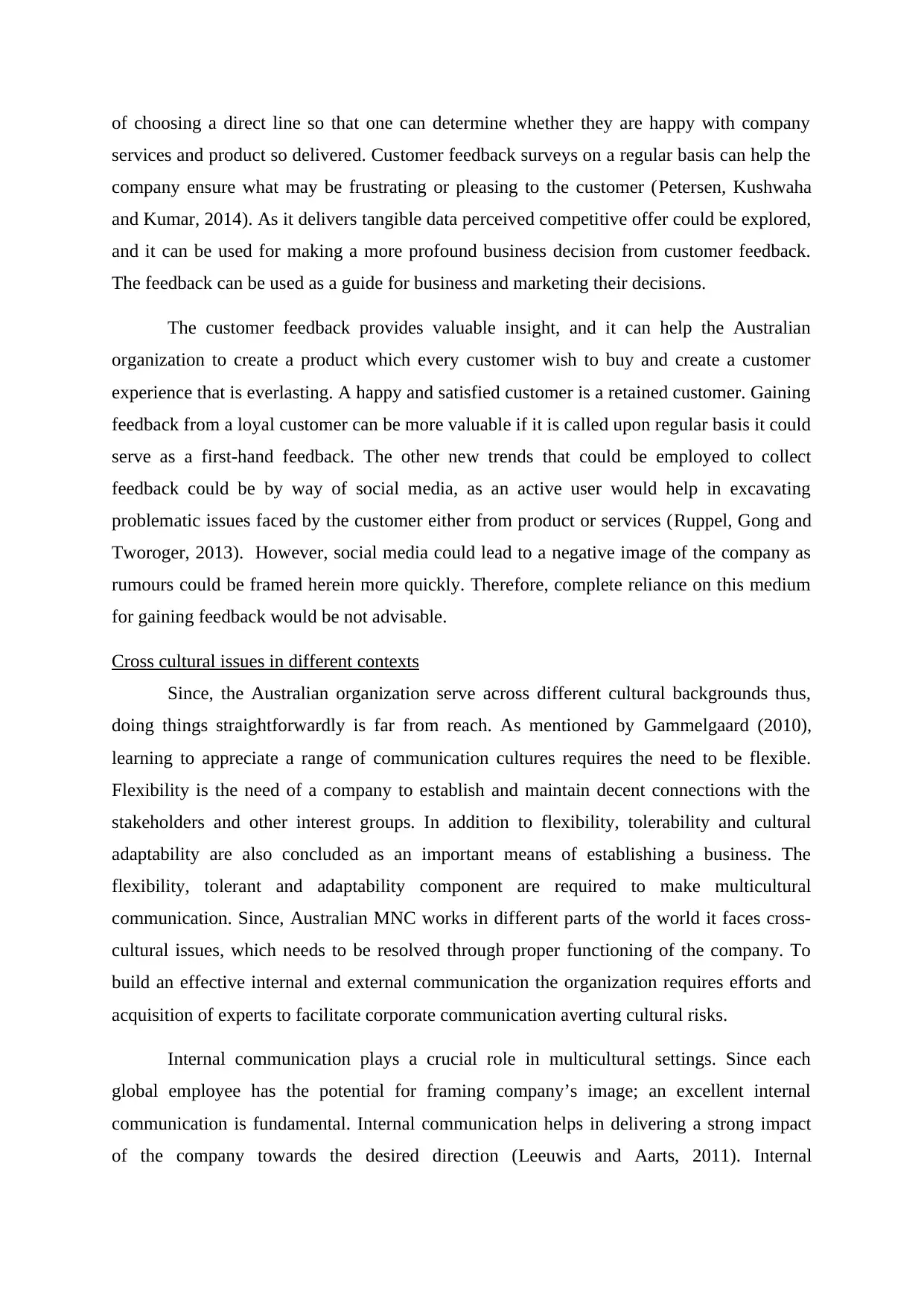
of choosing a direct line so that one can determine whether they are happy with company
services and product so delivered. Customer feedback surveys on a regular basis can help the
company ensure what may be frustrating or pleasing to the customer (Petersen, Kushwaha
and Kumar, 2014). As it delivers tangible data perceived competitive offer could be explored,
and it can be used for making a more profound business decision from customer feedback.
The feedback can be used as a guide for business and marketing their decisions.
The customer feedback provides valuable insight, and it can help the Australian
organization to create a product which every customer wish to buy and create a customer
experience that is everlasting. A happy and satisfied customer is a retained customer. Gaining
feedback from a loyal customer can be more valuable if it is called upon regular basis it could
serve as a first-hand feedback. The other new trends that could be employed to collect
feedback could be by way of social media, as an active user would help in excavating
problematic issues faced by the customer either from product or services (Ruppel, Gong and
Tworoger, 2013). However, social media could lead to a negative image of the company as
rumours could be framed herein more quickly. Therefore, complete reliance on this medium
for gaining feedback would be not advisable.
Cross cultural issues in different contexts
Since, the Australian organization serve across different cultural backgrounds thus,
doing things straightforwardly is far from reach. As mentioned by Gammelgaard (2010),
learning to appreciate a range of communication cultures requires the need to be flexible.
Flexibility is the need of a company to establish and maintain decent connections with the
stakeholders and other interest groups. In addition to flexibility, tolerability and cultural
adaptability are also concluded as an important means of establishing a business. The
flexibility, tolerant and adaptability component are required to make multicultural
communication. Since, Australian MNC works in different parts of the world it faces cross-
cultural issues, which needs to be resolved through proper functioning of the company. To
build an effective internal and external communication the organization requires efforts and
acquisition of experts to facilitate corporate communication averting cultural risks.
Internal communication plays a crucial role in multicultural settings. Since each
global employee has the potential for framing company’s image; an excellent internal
communication is fundamental. Internal communication helps in delivering a strong impact
of the company towards the desired direction (Leeuwis and Aarts, 2011). Internal
services and product so delivered. Customer feedback surveys on a regular basis can help the
company ensure what may be frustrating or pleasing to the customer (Petersen, Kushwaha
and Kumar, 2014). As it delivers tangible data perceived competitive offer could be explored,
and it can be used for making a more profound business decision from customer feedback.
The feedback can be used as a guide for business and marketing their decisions.
The customer feedback provides valuable insight, and it can help the Australian
organization to create a product which every customer wish to buy and create a customer
experience that is everlasting. A happy and satisfied customer is a retained customer. Gaining
feedback from a loyal customer can be more valuable if it is called upon regular basis it could
serve as a first-hand feedback. The other new trends that could be employed to collect
feedback could be by way of social media, as an active user would help in excavating
problematic issues faced by the customer either from product or services (Ruppel, Gong and
Tworoger, 2013). However, social media could lead to a negative image of the company as
rumours could be framed herein more quickly. Therefore, complete reliance on this medium
for gaining feedback would be not advisable.
Cross cultural issues in different contexts
Since, the Australian organization serve across different cultural backgrounds thus,
doing things straightforwardly is far from reach. As mentioned by Gammelgaard (2010),
learning to appreciate a range of communication cultures requires the need to be flexible.
Flexibility is the need of a company to establish and maintain decent connections with the
stakeholders and other interest groups. In addition to flexibility, tolerability and cultural
adaptability are also concluded as an important means of establishing a business. The
flexibility, tolerant and adaptability component are required to make multicultural
communication. Since, Australian MNC works in different parts of the world it faces cross-
cultural issues, which needs to be resolved through proper functioning of the company. To
build an effective internal and external communication the organization requires efforts and
acquisition of experts to facilitate corporate communication averting cultural risks.
Internal communication plays a crucial role in multicultural settings. Since each
global employee has the potential for framing company’s image; an excellent internal
communication is fundamental. Internal communication helps in delivering a strong impact
of the company towards the desired direction (Leeuwis and Aarts, 2011). Internal
Paraphrase This Document
Need a fresh take? Get an instant paraphrase of this document with our AI Paraphraser
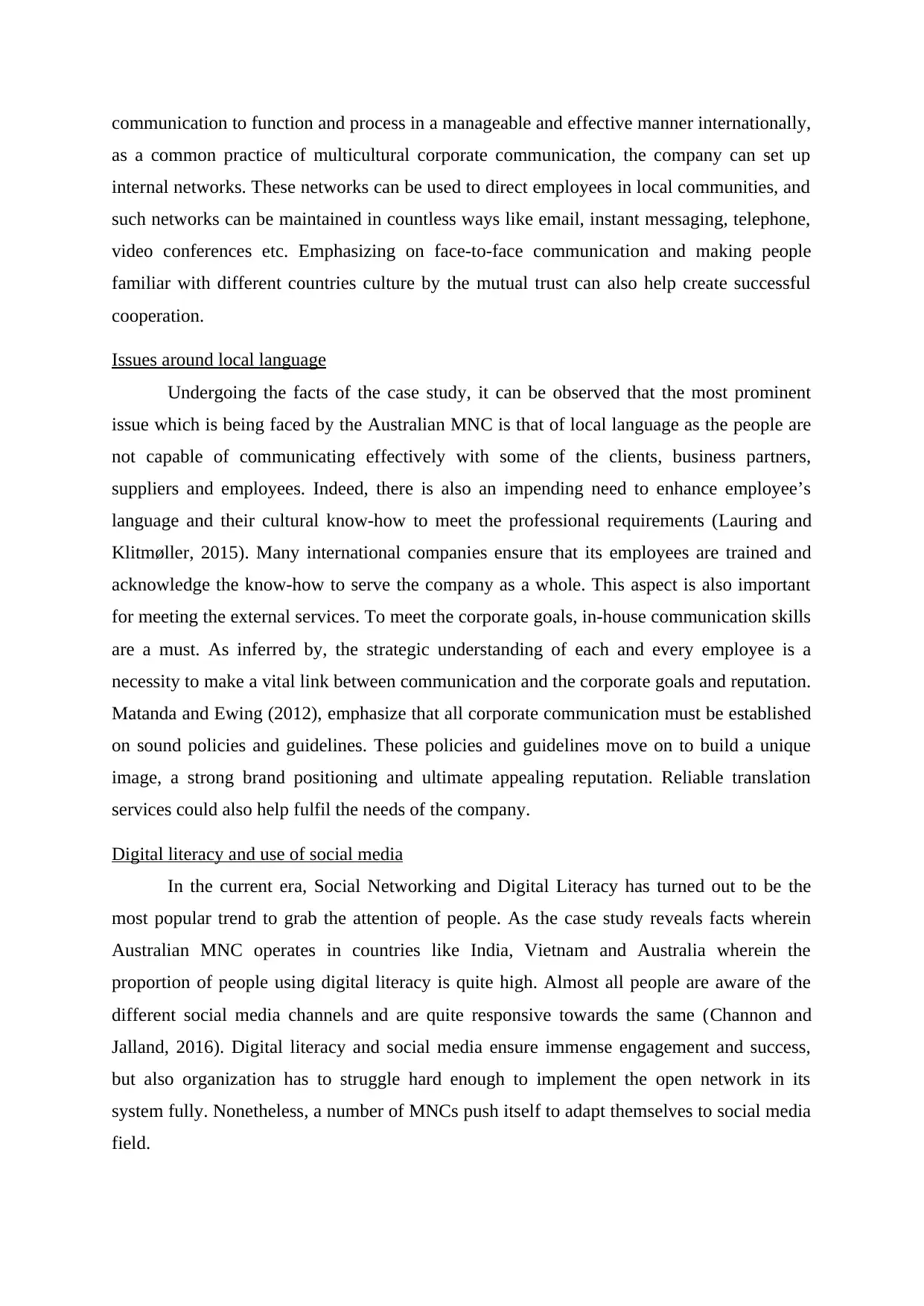
communication to function and process in a manageable and effective manner internationally,
as a common practice of multicultural corporate communication, the company can set up
internal networks. These networks can be used to direct employees in local communities, and
such networks can be maintained in countless ways like email, instant messaging, telephone,
video conferences etc. Emphasizing on face-to-face communication and making people
familiar with different countries culture by the mutual trust can also help create successful
cooperation.
Issues around local language
Undergoing the facts of the case study, it can be observed that the most prominent
issue which is being faced by the Australian MNC is that of local language as the people are
not capable of communicating effectively with some of the clients, business partners,
suppliers and employees. Indeed, there is also an impending need to enhance employee’s
language and their cultural know-how to meet the professional requirements (Lauring and
Klitmøller, 2015). Many international companies ensure that its employees are trained and
acknowledge the know-how to serve the company as a whole. This aspect is also important
for meeting the external services. To meet the corporate goals, in-house communication skills
are a must. As inferred by, the strategic understanding of each and every employee is a
necessity to make a vital link between communication and the corporate goals and reputation.
Matanda and Ewing (2012), emphasize that all corporate communication must be established
on sound policies and guidelines. These policies and guidelines move on to build a unique
image, a strong brand positioning and ultimate appealing reputation. Reliable translation
services could also help fulfil the needs of the company.
Digital literacy and use of social media
In the current era, Social Networking and Digital Literacy has turned out to be the
most popular trend to grab the attention of people. As the case study reveals facts wherein
Australian MNC operates in countries like India, Vietnam and Australia wherein the
proportion of people using digital literacy is quite high. Almost all people are aware of the
different social media channels and are quite responsive towards the same (Channon and
Jalland, 2016). Digital literacy and social media ensure immense engagement and success,
but also organization has to struggle hard enough to implement the open network in its
system fully. Nonetheless, a number of MNCs push itself to adapt themselves to social media
field.
as a common practice of multicultural corporate communication, the company can set up
internal networks. These networks can be used to direct employees in local communities, and
such networks can be maintained in countless ways like email, instant messaging, telephone,
video conferences etc. Emphasizing on face-to-face communication and making people
familiar with different countries culture by the mutual trust can also help create successful
cooperation.
Issues around local language
Undergoing the facts of the case study, it can be observed that the most prominent
issue which is being faced by the Australian MNC is that of local language as the people are
not capable of communicating effectively with some of the clients, business partners,
suppliers and employees. Indeed, there is also an impending need to enhance employee’s
language and their cultural know-how to meet the professional requirements (Lauring and
Klitmøller, 2015). Many international companies ensure that its employees are trained and
acknowledge the know-how to serve the company as a whole. This aspect is also important
for meeting the external services. To meet the corporate goals, in-house communication skills
are a must. As inferred by, the strategic understanding of each and every employee is a
necessity to make a vital link between communication and the corporate goals and reputation.
Matanda and Ewing (2012), emphasize that all corporate communication must be established
on sound policies and guidelines. These policies and guidelines move on to build a unique
image, a strong brand positioning and ultimate appealing reputation. Reliable translation
services could also help fulfil the needs of the company.
Digital literacy and use of social media
In the current era, Social Networking and Digital Literacy has turned out to be the
most popular trend to grab the attention of people. As the case study reveals facts wherein
Australian MNC operates in countries like India, Vietnam and Australia wherein the
proportion of people using digital literacy is quite high. Almost all people are aware of the
different social media channels and are quite responsive towards the same (Channon and
Jalland, 2016). Digital literacy and social media ensure immense engagement and success,
but also organization has to struggle hard enough to implement the open network in its
system fully. Nonetheless, a number of MNCs push itself to adapt themselves to social media
field.
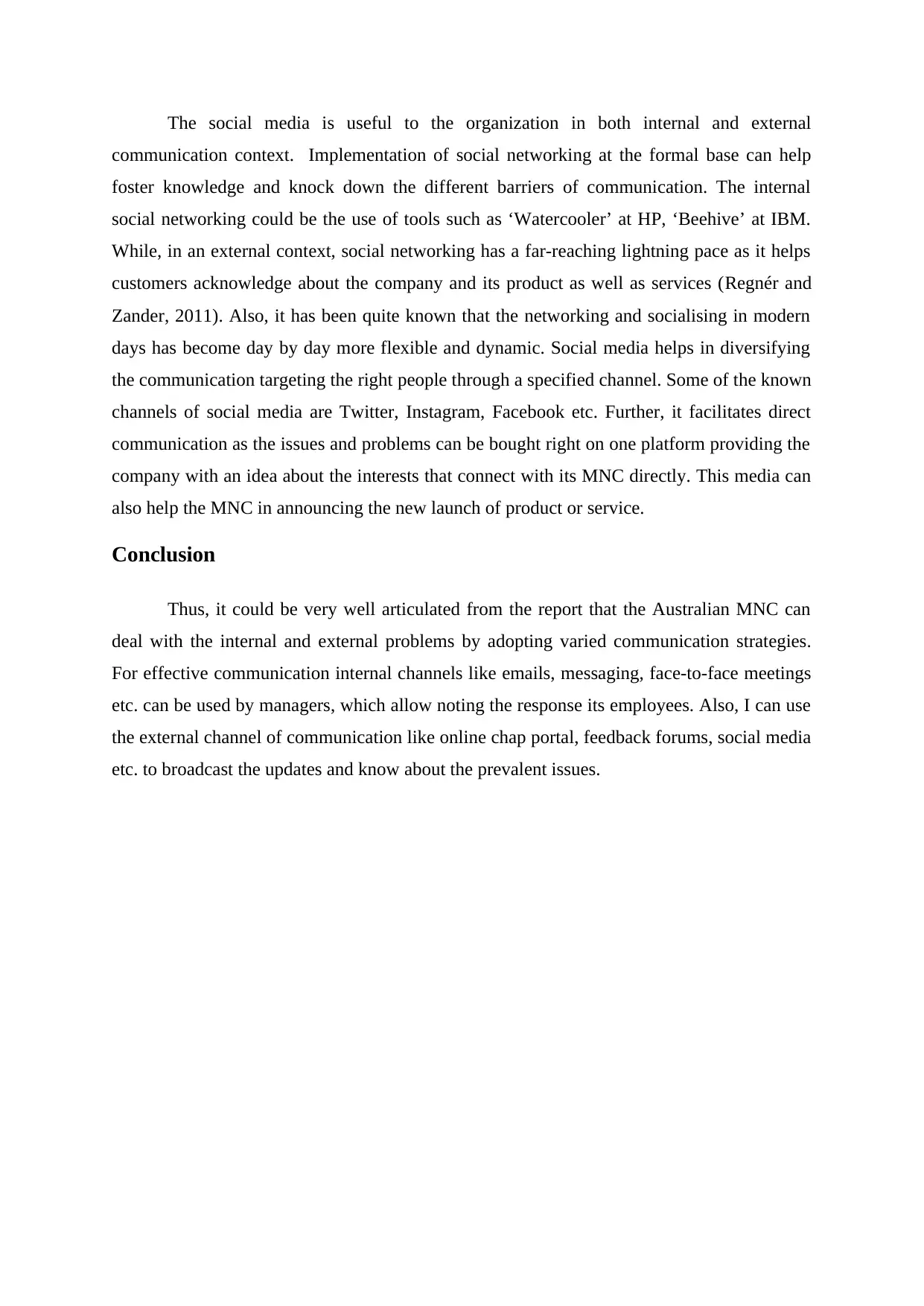
The social media is useful to the organization in both internal and external
communication context. Implementation of social networking at the formal base can help
foster knowledge and knock down the different barriers of communication. The internal
social networking could be the use of tools such as ‘Watercooler’ at HP, ‘Beehive’ at IBM.
While, in an external context, social networking has a far-reaching lightning pace as it helps
customers acknowledge about the company and its product as well as services (Regnér and
Zander, 2011). Also, it has been quite known that the networking and socialising in modern
days has become day by day more flexible and dynamic. Social media helps in diversifying
the communication targeting the right people through a specified channel. Some of the known
channels of social media are Twitter, Instagram, Facebook etc. Further, it facilitates direct
communication as the issues and problems can be bought right on one platform providing the
company with an idea about the interests that connect with its MNC directly. This media can
also help the MNC in announcing the new launch of product or service.
Conclusion
Thus, it could be very well articulated from the report that the Australian MNC can
deal with the internal and external problems by adopting varied communication strategies.
For effective communication internal channels like emails, messaging, face-to-face meetings
etc. can be used by managers, which allow noting the response its employees. Also, I can use
the external channel of communication like online chap portal, feedback forums, social media
etc. to broadcast the updates and know about the prevalent issues.
communication context. Implementation of social networking at the formal base can help
foster knowledge and knock down the different barriers of communication. The internal
social networking could be the use of tools such as ‘Watercooler’ at HP, ‘Beehive’ at IBM.
While, in an external context, social networking has a far-reaching lightning pace as it helps
customers acknowledge about the company and its product as well as services (Regnér and
Zander, 2011). Also, it has been quite known that the networking and socialising in modern
days has become day by day more flexible and dynamic. Social media helps in diversifying
the communication targeting the right people through a specified channel. Some of the known
channels of social media are Twitter, Instagram, Facebook etc. Further, it facilitates direct
communication as the issues and problems can be bought right on one platform providing the
company with an idea about the interests that connect with its MNC directly. This media can
also help the MNC in announcing the new launch of product or service.
Conclusion
Thus, it could be very well articulated from the report that the Australian MNC can
deal with the internal and external problems by adopting varied communication strategies.
For effective communication internal channels like emails, messaging, face-to-face meetings
etc. can be used by managers, which allow noting the response its employees. Also, I can use
the external channel of communication like online chap portal, feedback forums, social media
etc. to broadcast the updates and know about the prevalent issues.
⊘ This is a preview!⊘
Do you want full access?
Subscribe today to unlock all pages.

Trusted by 1+ million students worldwide
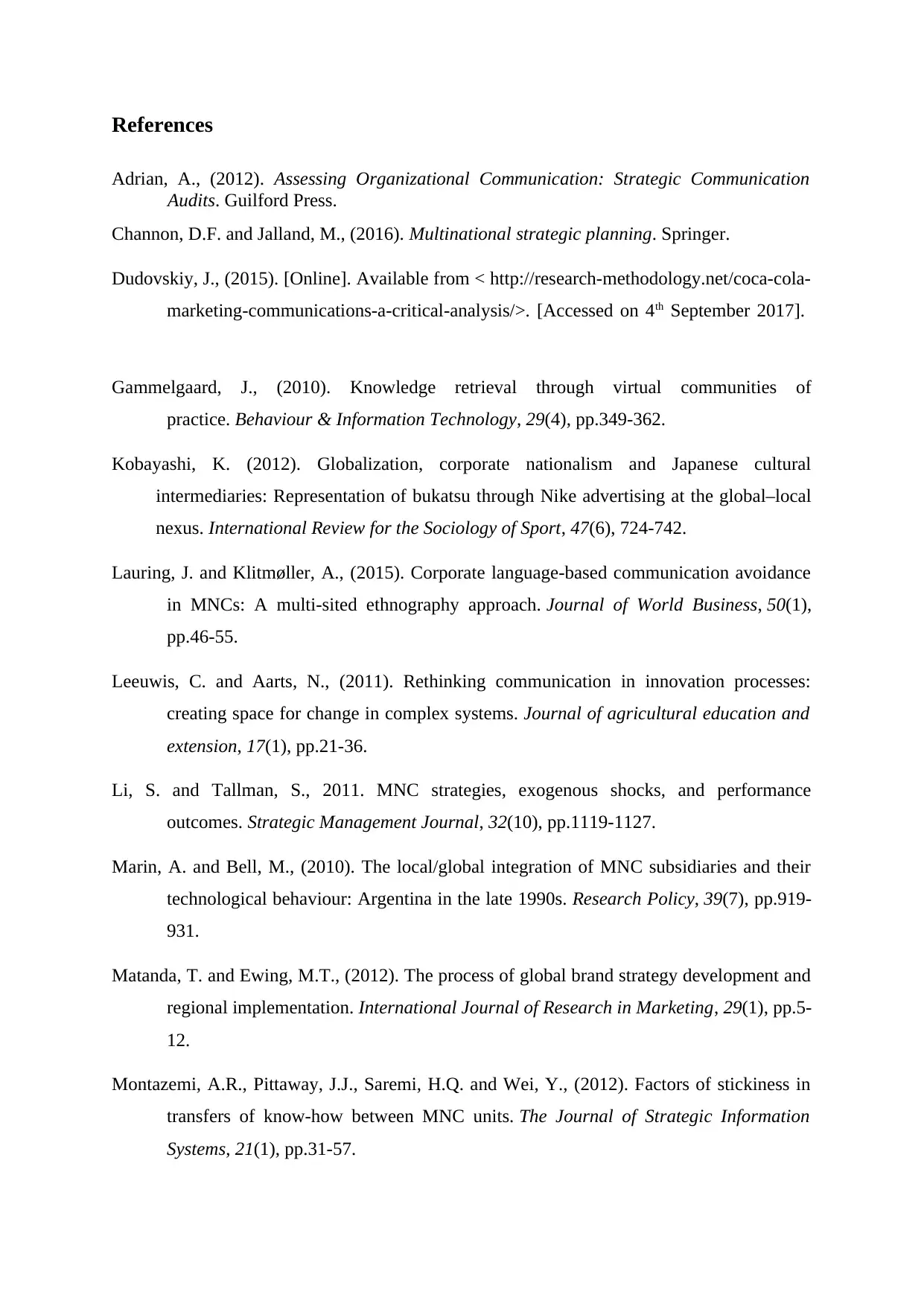
References
Adrian, A., (2012). Assessing Organizational Communication: Strategic Communication
Audits. Guilford Press.
Channon, D.F. and Jalland, M., (2016). Multinational strategic planning. Springer.
Dudovskiy, J., (2015). [Online]. Available from < http://research-methodology.net/coca-cola-
marketing-communications-a-critical-analysis/>. [Accessed on 4th September 2017].
Gammelgaard, J., (2010). Knowledge retrieval through virtual communities of
practice. Behaviour & Information Technology, 29(4), pp.349-362.
Kobayashi, K. (2012). Globalization, corporate nationalism and Japanese cultural
intermediaries: Representation of bukatsu through Nike advertising at the global–local
nexus. International Review for the Sociology of Sport, 47(6), 724-742.
Lauring, J. and Klitmøller, A., (2015). Corporate language-based communication avoidance
in MNCs: A multi-sited ethnography approach. Journal of World Business, 50(1),
pp.46-55.
Leeuwis, C. and Aarts, N., (2011). Rethinking communication in innovation processes:
creating space for change in complex systems. Journal of agricultural education and
extension, 17(1), pp.21-36.
Li, S. and Tallman, S., 2011. MNC strategies, exogenous shocks, and performance
outcomes. Strategic Management Journal, 32(10), pp.1119-1127.
Marin, A. and Bell, M., (2010). The local/global integration of MNC subsidiaries and their
technological behaviour: Argentina in the late 1990s. Research Policy, 39(7), pp.919-
931.
Matanda, T. and Ewing, M.T., (2012). The process of global brand strategy development and
regional implementation. International Journal of Research in Marketing, 29(1), pp.5-
12.
Montazemi, A.R., Pittaway, J.J., Saremi, H.Q. and Wei, Y., (2012). Factors of stickiness in
transfers of know-how between MNC units. The Journal of Strategic Information
Systems, 21(1), pp.31-57.
Adrian, A., (2012). Assessing Organizational Communication: Strategic Communication
Audits. Guilford Press.
Channon, D.F. and Jalland, M., (2016). Multinational strategic planning. Springer.
Dudovskiy, J., (2015). [Online]. Available from < http://research-methodology.net/coca-cola-
marketing-communications-a-critical-analysis/>. [Accessed on 4th September 2017].
Gammelgaard, J., (2010). Knowledge retrieval through virtual communities of
practice. Behaviour & Information Technology, 29(4), pp.349-362.
Kobayashi, K. (2012). Globalization, corporate nationalism and Japanese cultural
intermediaries: Representation of bukatsu through Nike advertising at the global–local
nexus. International Review for the Sociology of Sport, 47(6), 724-742.
Lauring, J. and Klitmøller, A., (2015). Corporate language-based communication avoidance
in MNCs: A multi-sited ethnography approach. Journal of World Business, 50(1),
pp.46-55.
Leeuwis, C. and Aarts, N., (2011). Rethinking communication in innovation processes:
creating space for change in complex systems. Journal of agricultural education and
extension, 17(1), pp.21-36.
Li, S. and Tallman, S., 2011. MNC strategies, exogenous shocks, and performance
outcomes. Strategic Management Journal, 32(10), pp.1119-1127.
Marin, A. and Bell, M., (2010). The local/global integration of MNC subsidiaries and their
technological behaviour: Argentina in the late 1990s. Research Policy, 39(7), pp.919-
931.
Matanda, T. and Ewing, M.T., (2012). The process of global brand strategy development and
regional implementation. International Journal of Research in Marketing, 29(1), pp.5-
12.
Montazemi, A.R., Pittaway, J.J., Saremi, H.Q. and Wei, Y., (2012). Factors of stickiness in
transfers of know-how between MNC units. The Journal of Strategic Information
Systems, 21(1), pp.31-57.
Paraphrase This Document
Need a fresh take? Get an instant paraphrase of this document with our AI Paraphraser
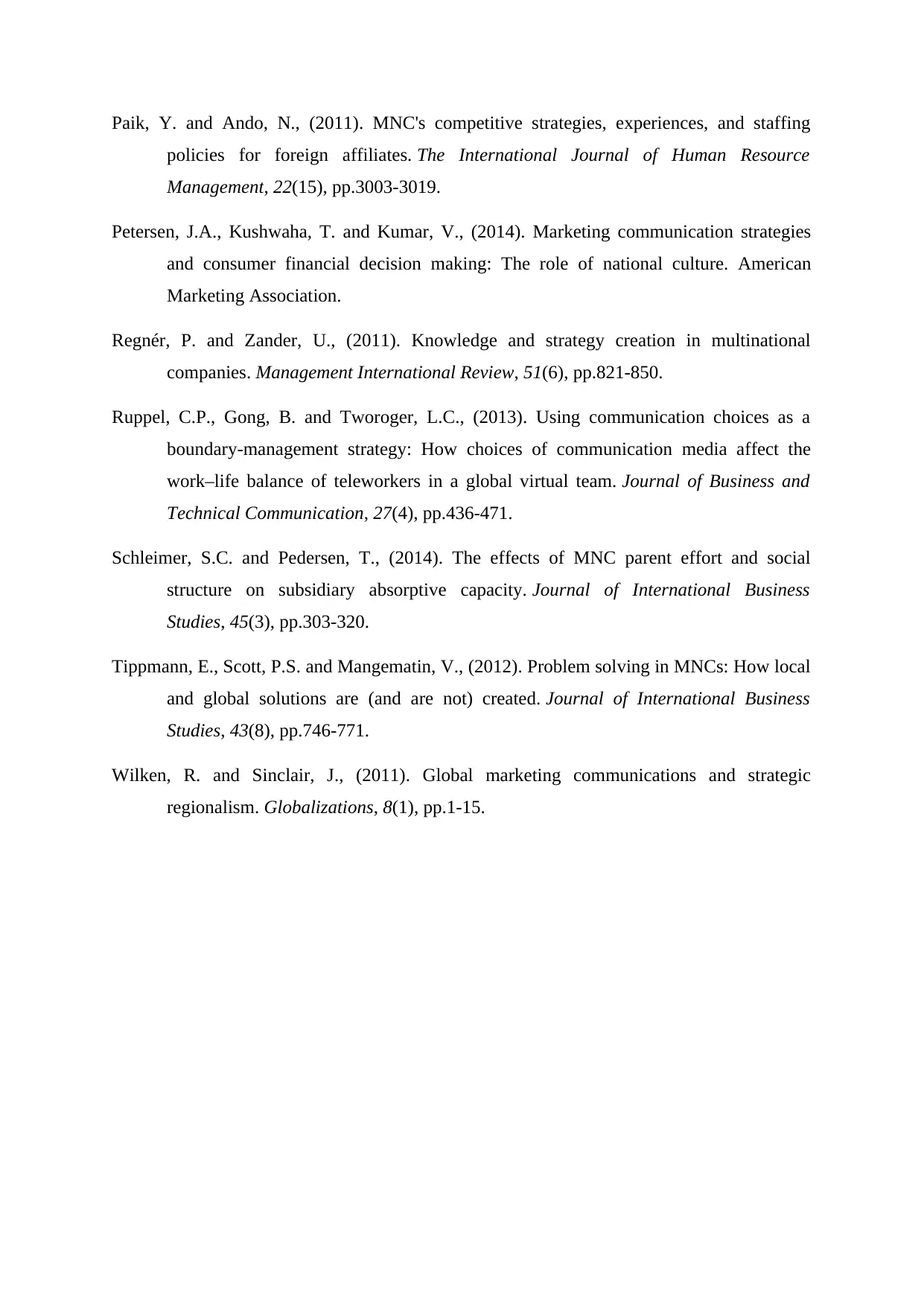
Paik, Y. and Ando, N., (2011). MNC's competitive strategies, experiences, and staffing
policies for foreign affiliates. The International Journal of Human Resource
Management, 22(15), pp.3003-3019.
Petersen, J.A., Kushwaha, T. and Kumar, V., (2014). Marketing communication strategies
and consumer financial decision making: The role of national culture. American
Marketing Association.
Regnér, P. and Zander, U., (2011). Knowledge and strategy creation in multinational
companies. Management International Review, 51(6), pp.821-850.
Ruppel, C.P., Gong, B. and Tworoger, L.C., (2013). Using communication choices as a
boundary-management strategy: How choices of communication media affect the
work–life balance of teleworkers in a global virtual team. Journal of Business and
Technical Communication, 27(4), pp.436-471.
Schleimer, S.C. and Pedersen, T., (2014). The effects of MNC parent effort and social
structure on subsidiary absorptive capacity. Journal of International Business
Studies, 45(3), pp.303-320.
Tippmann, E., Scott, P.S. and Mangematin, V., (2012). Problem solving in MNCs: How local
and global solutions are (and are not) created. Journal of International Business
Studies, 43(8), pp.746-771.
Wilken, R. and Sinclair, J., (2011). Global marketing communications and strategic
regionalism. Globalizations, 8(1), pp.1-15.
policies for foreign affiliates. The International Journal of Human Resource
Management, 22(15), pp.3003-3019.
Petersen, J.A., Kushwaha, T. and Kumar, V., (2014). Marketing communication strategies
and consumer financial decision making: The role of national culture. American
Marketing Association.
Regnér, P. and Zander, U., (2011). Knowledge and strategy creation in multinational
companies. Management International Review, 51(6), pp.821-850.
Ruppel, C.P., Gong, B. and Tworoger, L.C., (2013). Using communication choices as a
boundary-management strategy: How choices of communication media affect the
work–life balance of teleworkers in a global virtual team. Journal of Business and
Technical Communication, 27(4), pp.436-471.
Schleimer, S.C. and Pedersen, T., (2014). The effects of MNC parent effort and social
structure on subsidiary absorptive capacity. Journal of International Business
Studies, 45(3), pp.303-320.
Tippmann, E., Scott, P.S. and Mangematin, V., (2012). Problem solving in MNCs: How local
and global solutions are (and are not) created. Journal of International Business
Studies, 43(8), pp.746-771.
Wilken, R. and Sinclair, J., (2011). Global marketing communications and strategic
regionalism. Globalizations, 8(1), pp.1-15.
1 out of 11
Related Documents
Your All-in-One AI-Powered Toolkit for Academic Success.
+13062052269
info@desklib.com
Available 24*7 on WhatsApp / Email
![[object Object]](/_next/static/media/star-bottom.7253800d.svg)
Unlock your academic potential
Copyright © 2020–2025 A2Z Services. All Rights Reserved. Developed and managed by ZUCOL.





